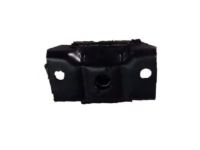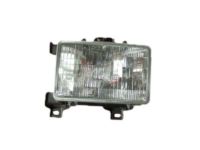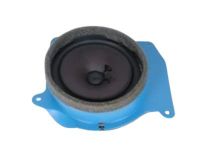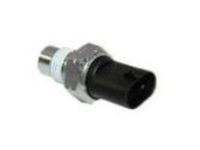
Why choose GMPartsGiant
- Large Inventory
The best site to buy GMC Jimmy genuine parts for years has been GMPartsGiant.com. We're the best online parts and accessory store for your GMC Jimmy. GMPartsGiant.com offers a large parts and accessory inventory to cover all your vehicle's repairs. Feel free to browse through our genuine GMC Jimmy parts and accessory catalog to find all your vehicle's needs.
- Fast Shipping Times
All of our GMC Jimmy auto parts and accessories are expedited directly from verified dealers and backed by the manufacturer's warranty. Our experienced team ensures the orders are packed to provide quick transit times. The majority of the orders are shipped out within a couple of business days to get the parts out to you as fast as possible.
- Low Prices
Our low prices say it all. You can rest assured that you will always receive unbeatable prices on OEM GMC Jimmy parts. Our giant inventory is beyond compare and has everything you need at an extraordinary value not found anywhere else. Whether you're restoring an old vehicle or upgrading the performance of your vehicle you can count on the quality of our products without hurting your bank account.
Popular Genuine GMC Jimmy Parts
- Engine Parts View More >
- Fuel System, Exhaust, Emission System Parts View More >
- Brakes Parts View More >
- Transmission - Automatic Parts View More >
- Frames, Springs, Shocks, Bumpers Parts View More >
- Cooling System, Grille, Oil System Parts View More >
- Front Axle, Front Suspension, Steering Parts View More >
- Front End Sheet Metal, Heater Parts View More >
Shop Genuine GMC Jimmy Parts with GMPartsGiant.com
Introduced in 1970 by General Motors, the GMC Jimmy was a versatile and reliable vehicle that remained in production until 1991, with its compact version enduring until 2002. Modeled after the Blazer, the Jimmy shared many parts and powertrain features with its Chevrolet counterpart, standing as GMC's premium offering. Its name interestingly mirrors the pronunciation of 'GM', akin to how 'Jeep' was derived from 'GP', or 'General Purpose'. The original Jimmy was a short-wheelbase, two-wheel-drive model, which in 1976 evolved into a semi-trailer design with enhanced safety and reduced leakage. This innovative design merged off-road capabilities with luxurious features like air conditioning and automatic transmission, traditionally exclusive to pickups. The majority of models sold were four-wheel drives, featuring a fixed front axle. Major component redesigns took place in 1973, introducing optional tilt steering among other upgrades. Despite the introduction of the GMT400 chassis in 1987, the Jimmy continued with its existing chassis until 1991. Innovations extended to combining the rear window and tailgate into a single unit, either manually operated or powered by an electric motor. The Jimmy transitioned to the use of the environmentally safer R134a refrigerant in 1994. As a testament to its popularity and reliability, the GMC Jimmy was still seen on the roads well after production had ceased, a model that combined comfort and durability in its design.
The GMC Jimmy, over various models, has manifested a series of recurrent problems. One predominant issue involves the leaking fuel tank. In the 1995 model, following a recent fuel pump replacement, fuel leakage becomes evident, especially when parked nose down on an incline. The root cause might trace back to oversight during pump installation, possibly from missing gaskets or incorrect seals. The 1996 model, post fuel line and vent replacements, reveals a similar issue, with gas escaping from a vent atop the tank. Potential causes include malfunctioning EVAP systems, overfilled tanks, flawed fuel line connectors, or a ruptured diaphragm in the fuel pump. Addressing this in the 1997 model requires pinpointing the leak, sanding, cleaning with degreaser, and applying an epoxy putty compound. Done correctly, this offers a long-term solution. Another concern, particularly in the 2000 and 2001 models, pertains to reverse gear failures. Often attributed to a faulty "sun shell" within the transmission, the ramifications can involve not just the loss of reverse but also second gear shifting problems. Signs include the transmission bypassing certain gears, and in some cases, a sporadic reverse function. Clicking noises in reverse, though potentially external, could be linked to the catalytic converter or engine torque-affecting components. Lastly, the transmission itself, pivotal for converting engine power into speed, can exhibit issues like delayed shifting, grinding, or even disturbing noises. For 2000 models, routine checks, particularly the consistent change of transmission fluid, are crucial. Professionals, such as those from Firestone Complete Auto Care, provide essential diagnostics and services, emphasizing proper and cost-effective repairs. Additionally, prolonged braking or excessive towing can further stress the transmission, emphasizing the importance of routine fluid checks and changes every 30,000 to 60,000 miles, though intervals might deviate based on vehicle usage.
When it comes to top-class quality and functionality, original equipment manufacturer parts are without doubt the only choice. They undergo strict quality checks and are built to GMC's factory specifications for easy installation. At GMPartsGiant.com, we make it easy for you to acquire top-quality OEM GMC Jimmy parts, like Transmission - Manual, Rear Body Structure, Moldings & Trim, Cargo Stowage at the most competitive prices. All our genuine GMC Jimmy parts, such as Transfer Case come with a manufacturer's warranty. In addition, we also provide a straightforward return policy and swift delivery services for your convenience.
GMC Jimmy Parts Questions & Answers
- Q: How can I check the condition of the motor and transmission mount on GMC Jimmy?A: To check the condition of the transmission mount, insert a large screwdriver or pry bar into the space between the transmission and the cross member and attempt to pry the transmission up slightly. If there is any noticeable separation of the rubber, it indicates that the mount is worn out. For removal, start by removing the nut that attaches the insulator to the cross member, as well as the bolts that attach the insulator to the transmission. Then, raise the transmission slightly using a jack and remove the insulator. When installing the new mount, ensure that the procedure is reversed and tighten the nuts and bolts securely.
- Q: How to adjust headlights on GMC Jimmy?A: To adjust a headlight, use spring-loaded screws for the beam headlights and Torx-head screw adjusters for composite headlights. You will need a blank wall, level floor beneath it; masking tape should be positioned vertically in reference to vehicle centerline and headlight centerlines on the wall. Also, a horizontal tape line may be positioned referring to the centreline of all headlights. The adjustments ought to be carried out while the vehicle is sitting level with half-full gas tank and no more than normal weight load inside it. When starting with low beam adjustment, place your high intensity zone two inches below the horizontal line but two inches to the right of vertical line coming from headlight. In order to raise or lower beam turn top adjusting screw clockwise or counterclockwise correspondingly while side adjusting screw is applied for moving light left or right. In High-beam mode, this concentrated brightness band should sit just below the horizontal line, centered vertically. After doing so then finally you can fix your lights as you see fit.
- Q: How to remove the car speakers on GMC Jimmy?A: To remove the radio, start by detaching the cable from the negative terminal of the battery. Then, remove the instrument cluster bezel and unscrew the radio. Disconnect the electrical connection and antenna lead before finally removing the radio from the dash. For installation, simply reverse the removal steps. When it comes to the speakers, if they are door-mounted, remove the door trim panel and drill out the rivets. Detach the speaker and unplug the electrical connector. Use a small hand-operated rivet gun for installing the new speaker. For front speakers, remove the speaker grille, screws, and detach the speaker. For rear speakers, remove the trim panel, nuts, and speaker.
- Q: How to check and replace the Neutral Safety Switch on GMC Jimmy?A: As of 1995 models, this switch makes sure your engine can only start when you have it either in Park or Neutral. Additionally, it completes the circuit connecting your backup lights when you switch to Reverse. When you start the engine and it's not in Park or Neutral, the switch that controls this needs either readjusting or replacing. Glue the safety stand under the car and disconnect the power wire from the control switch. When the key is off, look for current flowing between the switch terminals: there should be connection when the shift lever is in Park or Neutral and no connection in other positions, except for connection to the back-up lights while Reverse is chosen. When the switch shows problems, adjust it first and try again. If the switch keeps failing tests, you must replace it. Before taking off the shift control switch, apply the parking brake and put the transmission into neutral. Cut power from the vehicle, lift it onto jack stands, disconnect the battery's negative end, remove the shaft nut, unplug the electrical connection, unscrew the mounting bolts, and pull the switch off the shaft using care. To put the switch in, follow the manufacturer's guide to adjust it with their special tool. Make sure the detents match the tool's points and the locator pin is right where it should be. Before putting the switch on the shaft, clean away any rough edges and smooth them with a file. Then center the switch's flat sides over the shaft's flat sides, place it on, and slide until the mounting bracket's bottom touches the transmission ears. After putting the switch mounting bolts on and tightening them to their needed force, take out the tool for adjustments, and you're done with the installation. Turn everything back around to cut it all loose like you did at the beginning, except fasten the handle's holding nut to the correct tightness.




















































